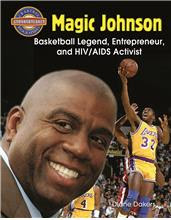| ________________
CM . . .
. Volume XXIII Number 32. . . April 28, 2017
excerpt:
Earvin “Magic” Johnson, Jr. grew up in a working-class, African American neighbourhood in Lansing, Michigan. New racial integration policies introduced in the early 1970s resulted in Earvin and most of his siblings being bused to an almost all-white secondary school that had a weak basketball team. Gradually, the white kids on the basketball team came around to accepting their new teammate who already stood six-foot-five (196 cm) and was their tallest player. Despite his height, Earvin was assigned the role of point-guard rather than center by his coach. This proved to be a perfect fit for Earvin. The team began winning games for a change. In his second year, local sports journalists heard about a whiz kid, and one decided that Earvin needed a unique nickname. “Magic” Johnson stuck and proved to be appropriate as the young player was soon being offered college scholarships by basketball recruiters. He announced his choice of Michigan State University in the spring of 1977. Dakers includes sufficient contextual information that non-sport followers can appreciate this biography. One of many information side stories is the creation of basketball in 1891 by Canadian-born James Naismith. Dakers also provides brief descriptions of some of the positions (notably point guard and center), the role of coaches and players who inspired Johnson and his rivalry with competitors like Larry Bird. During his brief career in the NCAA and then the professional NBA league that he joined at the age of nineteen in 1979, Johnson had a stellar career. He also earned top dollar and endured criticism during his early pro career following a conflict with a coach who was ultimately fired by the team owner. During the 1980s and beginning of the 1990s, Magic Johnson proved to be a great asset to the L.A. Lakers which frequently earned a position in the championship finals. Three times, in 1987, 1989 and 1990, Johnson was awarded the league’s coveted MVP (most valuable player) award. The book is heavily illustrated with a variety of black-and-white photographs of people named in the text, team portraits, action shots, informal off-court shots, and magazine covers featuring Johnson.
Johnson used his celebrity to promote education about HIV and AIDS. Many Americans had come to regard the virus and syndrome as concerns for only the gay community and injection drug users, a demographic that Dakers forgets to mention. Johnson’s message was powerful: all sexually active people are at risk of contracting the virus. Dakers addresses in an honest, non-judgmental way the fact that Johnson had sexual relations with many women, not just his longtime girlfriend and then wife. Without dwelling on this, Dakers emphasizes the important role that Johnson had in educating Americans about HIV and encouraging people to get tested and practice safer sex. His Magic Johnson Foundation, created in 1991, initially focused on HIV/AIDS education and research but later morphed to support “minority students” through 16 Community Empowerment Centers across the USA. Johnson’s return to basketball is noted as he came out of retirement more than once, played on the USA’s “Dream Team” in the Olympics and briefly coached his old team, the L.A. Lakers. The final chapter focuses on Johnson, the business person. It touches upon some of the numerous ventures that he engaged in, including sports broadcasting, real estate, and sports team ownership. Over the last three decades, great strides have been made in the treatment of HIV so that now it is considered a chronic illness rather than a death sentence. Johnson’s role in raising public awareness of HIV and AIDS and ongoing education cannot be underestimated. His success in business, philanthropy and AIDS activism are all noteworthy but it is his place in basketball history that stands out as the main focus of this biography. As with other volumes in the “Crabtree Groundbreaker Biographies” series, this volume includes a fine chronology, a glossary, index and further information that includes a few books, one being Johnson’s autobiography My Life written with William Novak and published in 1992. Also noted are three dvds and a couple of videos from the NBA website. Under websites, Dakers highlights a number of NBA resources and includes some other basketball sites and one educational site dealing with HIV/AIDS for a school audience. Highly Recommended. Val Ken Lem is a librarian at Ryerson University in Toronto, ON.
To comment
on this title or this review, send mail to cm@umanitoba.ca.
Copyright © the Manitoba Library Association. Reproduction for personal
use is permitted only if this copyright notice is maintained. Any
other reproduction is prohibited without permission.
Next Review | Table of Contents For This Issue -April 28, 2017 |
